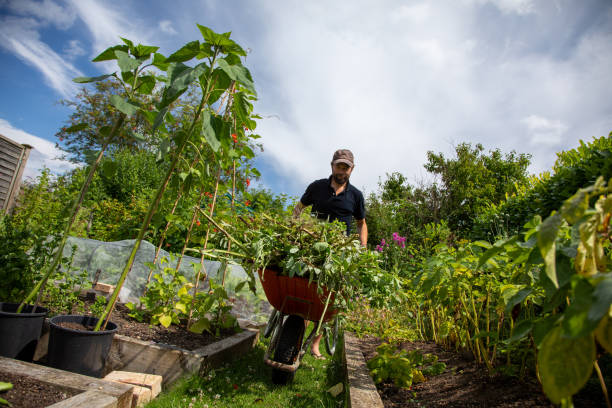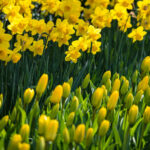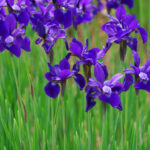Natural gardens, often referred to as wildlife or ecological gardens, are designed to foster biodiversity, mimic natural ecosystems, and promote sustainable gardening practices. Unlike traditional gardens that often rely on non-native plants and chemical inputs, natural gardens prioritize local flora and fauna, focusing on creating habitats that support various wildlife species. This approach not only benefits the environment but also enhances the beauty and functionality of outdoor spaces. In this guide, we will explore the principles of natural gardening, the benefits it offers, and practical steps for creating your own natural garden.
Understanding Natural Gardening
Natural gardening is rooted in the concept of sustainability and biodiversity. It emphasizes working with nature rather than against it, encouraging the growth of native plants, attracting beneficial insects, and creating habitats for local wildlife. Here are some core principles of natural gardening:
1. Native Plants
Native plants are those that naturally occur in a specific region without human introduction. They are adapted to the local climate, soil conditions, and wildlife, making them more resilient and easier to maintain than non-native species. Using native plants in your garden helps conserve local ecosystems and provides food and shelter for native wildlife.
2. Biodiversity
Biodiversity refers to the variety of life forms in a given area. In the context of gardening, promoting biodiversity means planting a diverse array of plants to attract different species of insects, birds, and other wildlife. A biodiverse garden is more resilient to pests and diseases, as it creates a balanced ecosystem where natural predators can thrive.
3. Organic Practices
Natural gardening encourages the use of organic practices to manage pests and enrich the soil. This includes avoiding synthetic fertilizers and pesticides, instead opting for compost, mulches, and natural pest control methods. Organic practices improve soil health and promote a vibrant ecosystem in your garden.
4. Water Conservation
Natural gardens often incorporate water conservation techniques, such as rain gardens, xeriscaping, and the use of permeable materials. These practices help manage stormwater runoff, reduce the need for irrigation, and create habitats for aquatic wildlife.
Benefits of Natural Gardens
Creating a natural garden comes with a myriad of benefits, both for the gardener and the environment. Here are some of the most significant advantages:
1. Environmental Conservation
Natural gardens play a crucial role in supporting local ecosystems. By planting native species and creating habitats, gardeners contribute to the conservation of biodiversity, helping to protect endangered plants and animals. Natural gardens can also help mitigate climate change by sequestering carbon, reducing urban heat, and managing stormwater.
2. Improved Soil Health
By focusing on organic practices and enriching the soil with compost and natural amendments, natural gardens promote healthy soil ecosystems. Healthy soil is rich in organic matter and microorganisms, which are essential for nutrient cycling and plant growth. This results in healthier plants that are better equipped to withstand stressors such as drought or disease.
3. Attracting Wildlife
Natural gardens attract a wide range of wildlife, including pollinators like bees and butterflies, beneficial insects, birds, and other small mammals. These species play vital roles in the ecosystem, contributing to pollination, pest control, and seed dispersal. A diverse garden teeming with life is a source of beauty and inspiration for any gardener.
4. Low Maintenance
Once established, natural gardens often require less maintenance than traditional gardens. Native plants are adapted to local conditions and typically require less water, fertilizer, and pest control. This means less work for the gardener and a more sustainable approach to landscaping.
5. Educational Opportunities
Natural gardens provide opportunities for education and engagement with nature. They can serve as living laboratories for children and adults alike, fostering a deeper understanding of ecology, biodiversity, and sustainable practices. Observing the interactions between plants, animals, and their environment can inspire a greater appreciation for nature and conservation.
Creating Your Own Natural Garden
Creating a natural garden involves thoughtful planning and consideration of your local environment. Here are some practical steps to help you get started:
1. Assess Your Space
Begin by assessing your garden space. Consider factors such as sunlight, soil type, moisture levels, and existing vegetation. Take note of any microclimates, such as shady areas or spots that receive full sun, as these will influence your plant choices.
2. Choose Native Plants
Research native plants that are well-suited to your region and garden conditions. Native plant nurseries or local extension services can provide valuable information and resources. Aim to select a mix of perennials, annuals, shrubs, and trees to create a diverse and visually appealing garden.
Some popular native plants include:
- Coneflower (Echinacea purpurea): Attracts pollinators and provides vibrant blooms.
- Black-eyed Susan (Rudbeckia hirta): A hardy perennial that adds color and supports beneficial insects.
- Milkweed (Asclepias spp.): Essential for monarch butterflies and other pollinators.
- Goldenrod (Solidago spp.): Provides nectar for late-season pollinators.
3. Design for Diversity
Plan your garden layout with diversity in mind. Group plants with similar water and sunlight needs together, and consider layering plants by height to create depth and interest. Incorporate features like birdhouses, bat boxes, and water sources to attract wildlife.
4. Improve Soil Health
Prepare your soil by removing weeds, rocks, and debris. Amend the soil with compost or organic matter to enhance fertility and structure. Conducting a soil test can provide insight into nutrient levels and pH, allowing you to make informed decisions about amendments.
5. Incorporate Water Features
If possible, consider adding water features such as ponds, rain gardens, or birdbaths. These features provide essential habitats for aquatic wildlife and attract birds and insects. Water features also enhance the aesthetic appeal of your garden.
6. Practice Organic Gardening
Commit to organic gardening practices by avoiding synthetic fertilizers and pesticides. Instead, use compost, natural mulches, and crop rotation to nourish your plants and manage pests. Planting companion plants, such as marigolds, can deter harmful insects while attracting beneficial ones.
7. Maintain Your Garden
While natural gardens are generally low maintenance, they still require regular care. Monitor your garden for weeds, pests, and diseases, and address any issues promptly. Prune and deadhead plants as needed to encourage healthy growth and maintain an attractive appearance.
Encouraging Wildlife in Your Natural Garden
Attracting wildlife to your garden involves creating a welcoming environment. Here are some tips to enhance your garden’s appeal to local wildlife:
1. Provide Food Sources
Plant a diverse array of flowering plants to provide nectar for pollinators and seeds for birds. Incorporating berry-producing shrubs and trees will offer additional food sources for birds and small mammals.
2. Create Shelter
Include a variety of habitats in your garden, such as dense shrubs, tall grasses, and logs or rocks for shelter. Birdhouses, bat boxes, and insect hotels can also provide safe spaces for wildlife to nest and thrive.
3. Limit Chemical Use
Avoid using chemicals that can harm wildlife, including pesticides and herbicides. Instead, focus on organic practices that promote a healthy ecosystem.
4. Be Patient
It may take time for wildlife to discover and inhabit your natural garden. Be patient and allow the ecosystem to develop naturally. The presence of wildlife will increase as the garden matures and provides food and habitat.
Conclusion
Natural gardens represent a holistic approach to gardening that prioritizes biodiversity, sustainability, and environmental stewardship. By embracing native plants, organic practices, and ecological design, gardeners can create beautiful outdoor spaces that support local wildlife and enhance the overall health of the ecosystem. Whether you have a small backyard or a larger landscape, creating a natural garden is an opportunity to connect with nature, promote conservation, and enjoy the beauty of a thriving, diverse environment. Through mindful practices and thoughtful planning, you can cultivate a natural garden that benefits both you and the planet.







